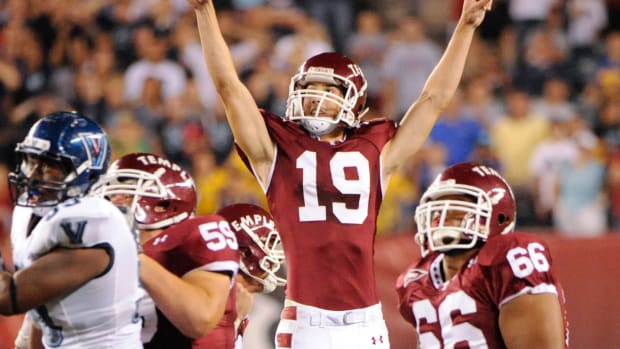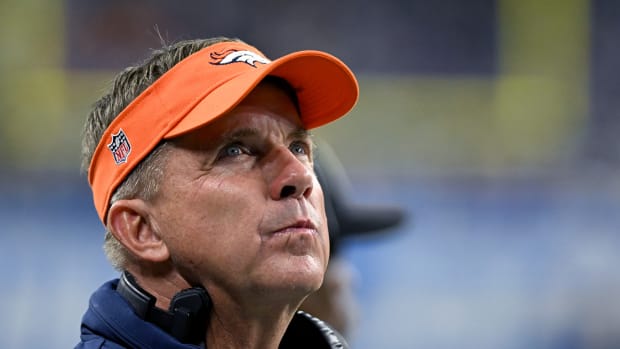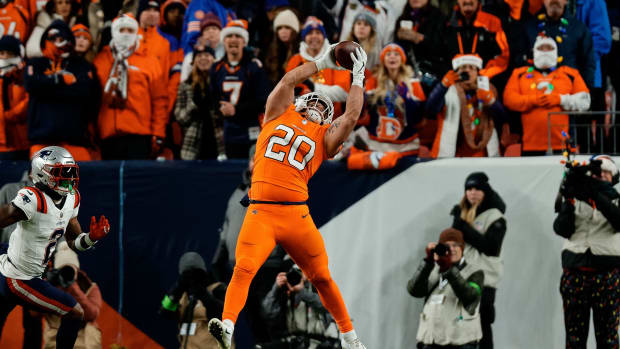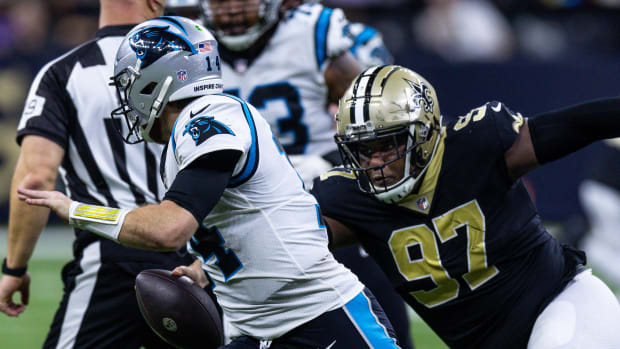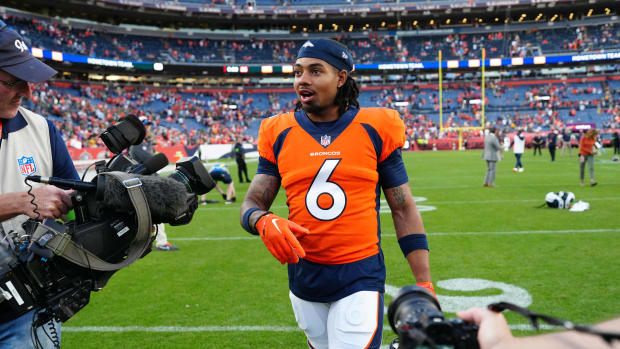Analyzing What it'll Cost Broncos to Re-Sign S Justin Simmons
With the 2019 NFL season nearing its end, plenty of fans are already thinking about the offseason and what it will mean for the Denver Broncos.
Considering that the Broncos are projected to have $68M in cap space (assuming a $200M league-wide cap) before any players under contract are released, plus nine draft picks and three projected compensatory picks, the team is in a good position to improve the roster.
But that cap space won't just be to add free agents from other teams — it's likely to be utilized to extend current Broncos with expiring contracts.
Among those players is free safety Justin Simmons, who has improved during the course of the season and looks like a keeper. Plenty of fans may wonder why the Broncos haven't gotten a deal done with the 2016 third-round pick.
Before we get into what Simmons is likely to command in a contract, let's examine why a deal hasn't been agreed to that quickly, not just for Simmons, but for the bulk of players with expiring contracts.
Negotiations for contract extensions aren't always swiftly accomplished. Teams have to determine what they are willing to offer and agents must determine what they want to seek for the players they represent. This process doesn't always happen quickly.
Perhaps one way to think about this is to think about what it means when you explore the housing market. If you are a buyer, you are going to want to pay the lowest possible price for a home, while understanding that you have to consider the current market for the home you want. If you are a seller, you are going to want to get the highest possible price for the home, but take into account the current market for your home.
As a buyer, though, you have to realize that 'lowest possible price' doesn't always mean 'low price'. What you do, therefore, is set your ceiling for what you will pay and ask for less than that to start.
That way, you hope for counteroffers that come in at or below your ceiling. If your initial offer is at your ceiling, though, you will be paying more than you want.
As a seller, the 'highest possible price' doesn't always mean 'high price'. Here, you set the floor for as low as you are willing to sell, then put your initial asking price above that. Your intent is to get a final offer at or above the floor you set. Put your initial price at your floor and your final offer is more likely to come in lower than you want.
In NFL free agency, the teams' front offices are the equivalent of home buyers, while the player agents are the equivalent of home sellers. Each side has to know the limits they will set in terms of how high (front offices) or how low (player agents) they will go with agreed-upon prices.
And when it comes to sellers, because they want the highest possible price, it's to their advantage to have a bigger market. A home seller with a house recently on the market and buyers lined up is going to have a bigger market than a home seller who has had the house on the market for a long time with hardly any buyers interested.
Similarly, player agents who have a player that recently hit the open market, with plenty of suitors for his services, will get better deals than those who have been waiting for a while to sign but little to no suitors.
And because player agents want the biggest market possible, it's not surprising that they would want to convince their clients to test free agency first, rather than accept the first offer they get from a team. This would explain why players such as Simmons haven't signed yet.
However, the Broncos offering a deal that Simmons thinks he can't pass up could get him to agree to terms. But that's where the Broncos have to be careful how high they go, much like a home buyer must be careful about going too high on a house purchase.
So what should the Broncos be expecting to offer?
The Factors at Hand
First, the safety market favored the players who hit free agency in 2019, one year after the market for safeties didn't favor players. Simmons' agent is certainly keeping 2019 in mind and sees an opportunity to set the market to a new high. The Broncos are likely doing the same, though asking if they are willing to go higher or would prefer to keep the price down.
Second, the number of safeties set to hit free agency is a pretty solid group, though it's more of a top-heavy group in terms of the quality of players. From an agent standpoint, it's likely a good bet for Simmons to hit the open market. From a team standpoint, it's a question of whether the Broncos should do whatever it takes to keep Simmons or take their chance on a player who might not be as talented, but represents better value.
Third, there's the question of what is most important to Simmons. If he would prefer to stay with the team that drafted him, if he likes playing for Vic Fangio and he feels comfortable with his role in the defense, he is more likely to want to get a deal done with the Broncos. But if his preference is long-term security in the form of a big contract, he is more likely to want to test the market and get the highest possible deal.
Fourth, there are multiple factors that impact a contract which must be considered, such as the total amount that's fully guaranteed (which is more favorable to a player), what injury-only guarantees are in place (gives the player a little peace of mind, but allows the team an out if cap space is needed or the player's skill declines), how team options work (the earlier the team must decide on exercising an option, the sooner a player may hit the open market) and what roster bonuses look like (those that pay a set amount on a given date are better for players than per-game roster bonuses, which aren't earned if a player is inactive).
Knowing these factors can help the Broncos figure out what's the best offer to present to Simmons, and for the player's agent to understand how to best negotiate a good offer for his client.
Market Value
To understand what's likely coming in a new contract for Simmons, let's examine the contracts for the highest-paid safeties:
Kevin Byard: The Titans extended their 2016 third-round pick earlier this year. His five-year, $70.5M contract averages $14.1M per year. That sounds like a good deal, but consider the fully guaranteed money: He got $19.625M in full guarantees, which is less than what other high-paid safeties are getting, and the Titans could cut him for skill or cap reasons after 2020 (thought not for injury reasons). Thus, the highest APY salary among safeties doesn't look as appealing as upon first glance.
Tyrann Mathieu: The Chiefs gave Mathieu $42M for three years, averaging $14M per year. On one hand, the APY salary is high. On the other hand, it's just a three-year deal. Then again, he got $26.8M in full guarantees, representing more than half the contract. It's a true 'two years then we'll see' deal, but it's not quite a long-term commitment.
Landon Collins: He got $84M in a six-year deal from the Redskins, but even though that's $14M APY, just $31M of the contract is fully guaranteed. However, the contract structure means the Redskins can only get out of the deal in 2021 without negative cap consequences by using a post-June 1 designation. So Collins is likely assured of $12.5M in base salary in 2021, making it closer to a 'three years then we'll see' type of deal.
Earl Thomas: He signed with the Ravens for $55M over four years, averaging $13.75M per year, but got the majority of the contract fully guaranteed to the tune of $32M. The Ravens can get out of the deal in 2021 from a cash standpoint, though the dead money charge will be higher than cap space freed. Thomas has a chance to collect $11M in 2021, but it's far from a sure thing.
Reshad Jones: He signed his contract with the Dolphins several seasons ago, but it is useful to examine anyway. In 2017, he signed a four-year extension worth $48M, or $12M APY salary. He got $19.885M fully guaranteed and $33M in total guarantees. He will collected the entire $33M once the 2019 season is over, meaning he will have collected nearly 69 percent of the contract.
Kareem Jackson: The Broncos gave Jackson a three-year deal for $33M, so the $11M per year is the lowest APY among these safeties. However, he got $23M in fully guaranteed money, meaning he'll get almost 70 percent of the contract. From a commitment standpoint, Jackson is only guaranteed two years with the Broncos, but he'll get a large amount of the money in the contract he signed.
Bottom Line
For Simmons, the best thing is to get as much fully guaranteed money as possible, which can be done in part by his agent getting the Broncos to truly commit to Simmons for at least half the contract length. That would mean if the Broncos want a four-year deal, Simmons' agent absolutely will want that to be a full commitment for the next two years. If the Broncos offer a five-year deal, Simmons' agent should try to get a deal that keeps Simmons with the team for three seasons.
From the Broncos' standpoint, a four-year deal makes more sense because safety isn't a premium position. However, the Broncos will likely need to be prepared to treat Simmons just as they did Jackson by fully guaranteeing two years' worth of money to Simmons. They might be able to get Simmons to take less than some of the higher-paid safeties in terms of APY salary, but they are likely to have to offer more in fully guaranteed money.
It would make sense for the Broncos to be willing to go higher than what Earl Thomas received, but not to set the market at new heights. A four-year deal worth $56M would put Simmons around the same APY as Collins and Mathieu, but perhaps they can get Simmons to take a slightly lower total sum. However, I would expect the fully guaranteed money to be at least $34M, which would become the highest among all safeties.
The Broncos could make a four-year, $56M deal work with a $10M signing bonus and spreading the remaining $24M among his 2020 and 2021 base salaries. That would leave $22M to spread out in the final two years.
The Broncos typically add team options to the final year of their long-term contracts, but Simmons' agent should make sure the option is similar to other Broncos, in that the team must exercise or decline by the start of the new league year. That way, Simmons can hit the open market earlier if the Broncos decide not to keep him.
In the end, I wouldn't expect Simmons to set the market too high, but he's going to be among the higher-paid safeties. The Broncos could get away with not making Simmons the highest-paid safety in terms of APY salary, but Simmons' agent should certainly seek at least two years' worth of fully guaranteed money.
In the end, I expect the Broncos to get a deal done shortly after the season ends, but there will be concessions made on both sides. One thing is clear, though: No matter what those concessions are, Simmons is going to be in line for a big payday.
Follow Bob on Twitter @BobMorrisSports and @MileHighHuddle.

